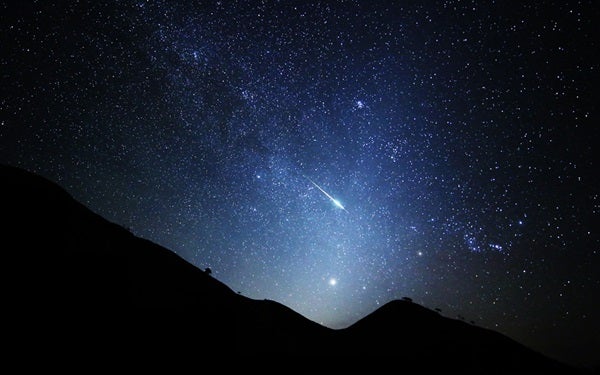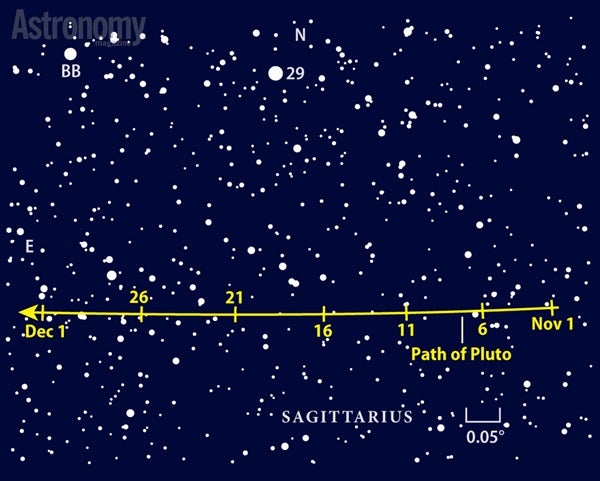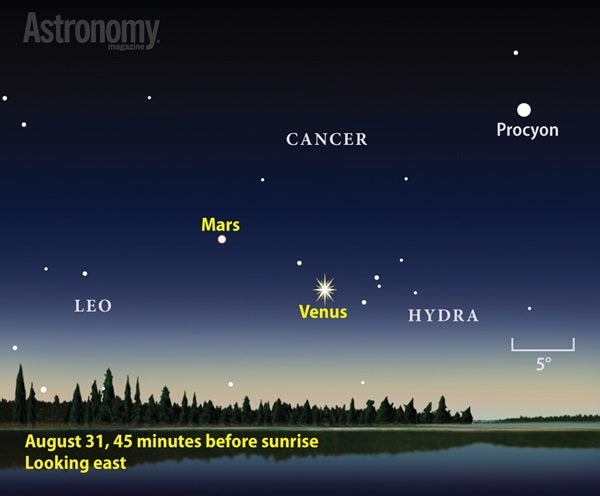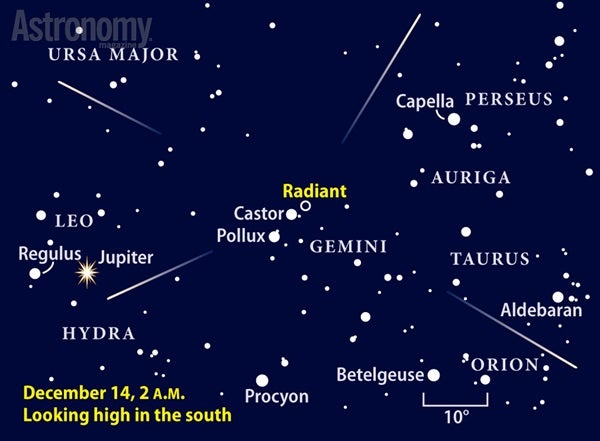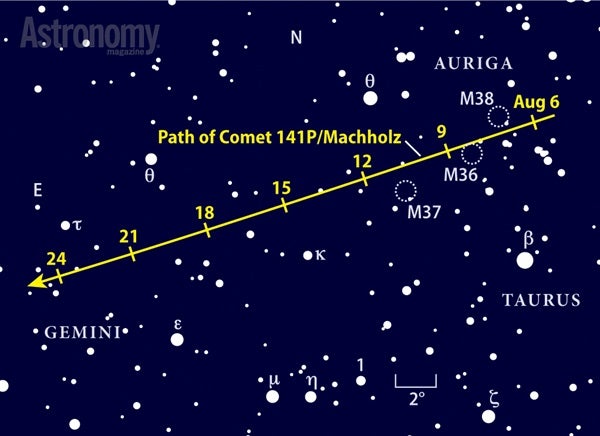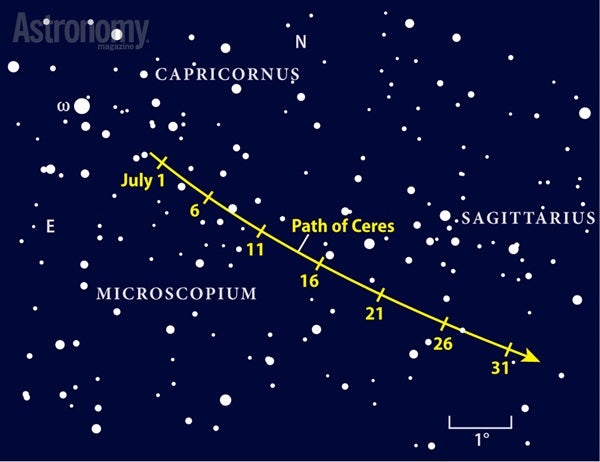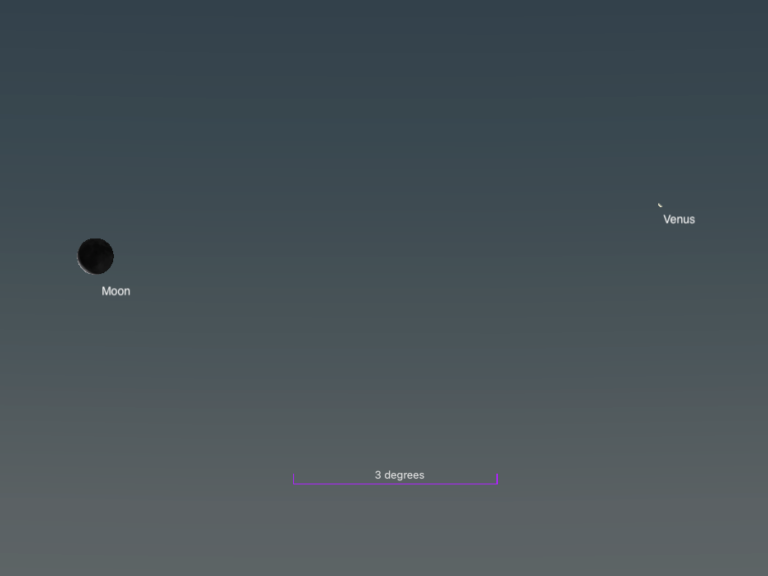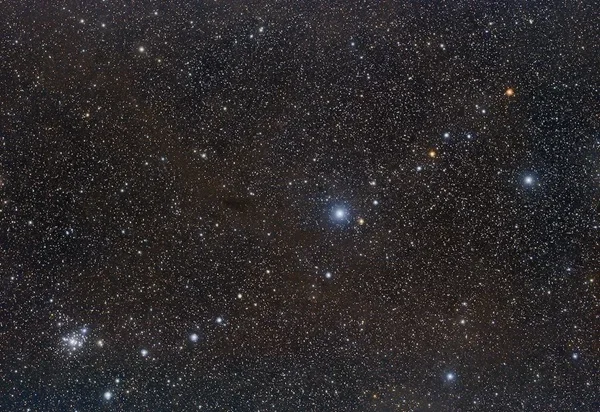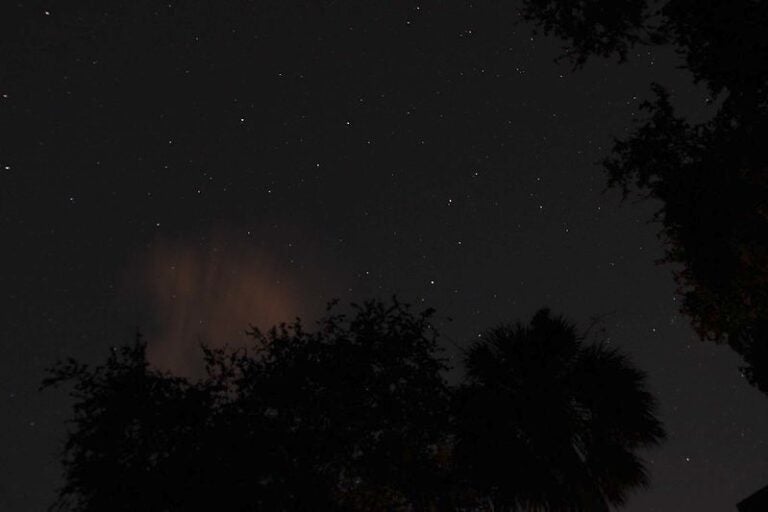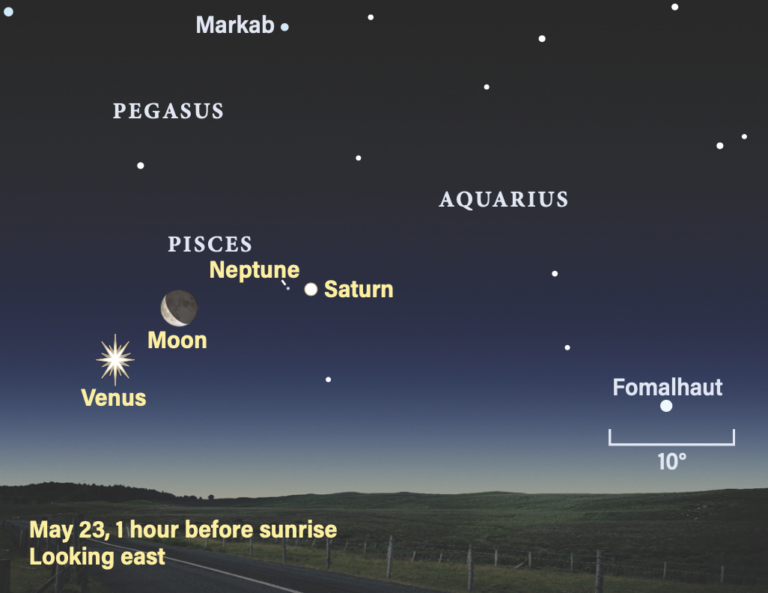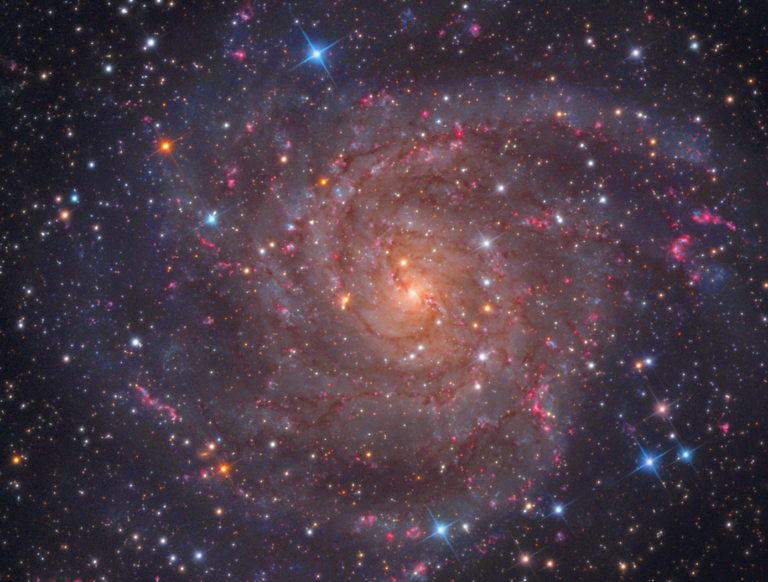For those who prefer viewing planets, the month has its own rewards. Evening twilight in early August offers fleeting glimpses of Mercury, Venus, and Jupiter. Then, once darkness settles in, beautiful Saturn takes center stage. The overnight hours belong to Neptune, which comes to opposition and peak visibility in August, and Pluto, which reached the same point relative to Earth just a month earlier. Shortly before dawn at August’s close, Venus returns to view after a three-week pause while Mars comes back after a four-month hiatus.
Head outside shortly after sunset as August begins, and you might catch a trio of solar system objects. Jupiter will be the easiest to spot. From 30° north latitude, the giant planet stands 6° high in the west a half-hour after sundown. Shining at magnitude –1.7, it should barely peek through the bright twilight. Venus gleams even brighter, at magnitude –4.4, but lies to Jupiter’s lower left at just 2° altitude. Magnitude –1.2 Mercury resides to the lower right of Jupiter and is just 1° high — invisible without binoculars and near-perfect viewing conditions.
The planets appear higher the farther south you live. From equatorial regions, for example, Venus and Jupiter appear side by side and some 10° above the horizon 30 minutes after sunset. These two drop out of sight by the end of August’s first week, though you still might catch Jupiter within 1° of Mercury on the 6th. Venus slides between the Sun and Earth on August 15, while Jupiter passes on the Sun’s far side on the 26th.
Mercury fares significantly better as the month progresses because its angular separation from our star increases. Look for it August 16 when a 2-day-old crescent Moon lies 5° to its left. By the 31st, Mercury climbs 7° high in the west a half-hour after sundown. Glowing at magnitude 0.1, it won’t be obvious unless you use optical aid. Through a telescope, the innermost planet then appears 7″ across and about 60 percent illuminated.
Saturn makes little progress, however — it spends the entire month 13° northwest of Antares, the brightest star in neighboring Scorpius. Saturn shines at magnitude 0.5, approximately 75 percent brighter than Antares.
Naked eyes don’t do Saturn justice, however. You need a telescope to see the planet’s beautiful rings, a sight without equal in Earth’s sky. Even a small instrument delivers gorgeous views. At midmonth, the planet’s disk measures 17″ across while the rings span 38″ and tip 24° to our line of sight. The large tilt provides a detailed look at the ring system’s structure, most noticeably revealing the dark Cassini Division that separates the outer A ring from the brighter B ring.
Speaking of viewing angles, Saturn reaches quadrature August 22. If you were to draw a line from the Sun to Earth and then to Saturn on this date, it would form a 90° angle. To an observer, quadrature means the shadow cast by Saturn falls as far east of the planet as possible and hides a noticeable section of the rings’ far side from view. The effect makes the planet look particularly three-dimensional, and it lasts for a few weeks.
Several of Saturn’s moons also show up through small telescopes. The largest, 8th-magnitude Titan, is the brightest object near the planet. The satellite appears due north of Saturn on August 7 and 23 and due south August 14 and 30.
By the time August rolls around, Pluto should be transformed from a fuzzy blob into a world of stark landscapes and who knows what else thanks to the July 14 flyby of NASA’s New Horizons spacecraft. The encounter undoubtedly will raise Pluto’s stature and spark a desire among observers to see it with their own eyes.
To track down the 14th-magnitude point of light, you’ll need an 8-inch or larger scope, a dark sky, and a detailed star chart (see p. 36). Fortunately, it lies in an area of northeastern Sagittarius occupied by a couple of bright stars. On August 1, Pluto stands 60 percent of the way along a line joining magnitude 3.5 Xi2 (ξ2) Sagittarii and its magnitude 5.1 neighbor, Xi1 (ξ1) Sgr. As August progresses, the distant world moves to the west, ending the month 35′ west-northwest of Xi2. To confirm a sighting, plot the star field and come back a night or two later. The object that moved is Pluto.
The other two outer planets are also on display most of the night and have the distinct advantage of being easy to spot through binoculars. Neptune comes into view first. This ice giant world reaches peak visibility when it lies opposite the Sun in our sky August 31. It then rises at sunset, appears highest in the south around 1 a.m. local daylight time, and sets as the Sun comes up. It also shines brightest at opposition, reaching magnitude 7.8, though it is only imperceptibly dimmer the rest of the month.
To locate Neptune, first find magnitude 3.8 Lambda (λ) Aquarii, which lies about 10° southeast of Aquarius’ distinctive Water Jar asterism. At opposition, Neptune lies 3.4° southwest of Lambda (see the finder chart on p. 42). Don’t confuse the planet with a magnitude 6.9 star located just 9′ to its southwest. Use a telescope to differentiate the two. Neptune shows a 2.4″-diameter disk with a blue-gray hue, while the star appears as a mere point of light.
Uranus hovers within 0.6° of Zeta throughout August, beginning the month southeast of the star and ending it a bit west of due south. When viewed through a telescope, Uranus shows a disk that measures 3.6″ across and appears distinctly blue-green.
Although the predawn sky is bereft of planet activity in early August, things pick up considerably by month’s end. You might catch a glimpse of Mars by midmonth, when the planet rises 90 minutes before the Sun and climbs 5° high an hour before sunrise. It shines at magnitude 1.7, so you’ll likely need binoculars to pick it out of the twilight glow.
The Red Planet’s most interesting event this month comes on the 20th when it crosses the famous Beehive star cluster (M44) in Cancer the Crab. The low altitude and competing twilight will make the pair, and M44 in particular, challenging to see even with optical aid. But it’s worth the attempt if you have excellent sky conditions.
Mars becomes a bit easier to see as it climbs higher by the end of August, but by then Venus will dominate the morning sky. After passing through inferior conjunction on the 15th, the inner planet jumps into view during August’s final week. Gleaming at magnitude –4.5, it appears conspicuous in the eastern sky even during twilight. On the 31st, you can find Mars 9° to Venus’ upper left. Through a telescope, the inner world shows a giant disk 52″ across and just 8 percent lit.
When most amateur astronomers hear the name “Aries,” they immediately think of the zodiacal constellation of the Ram. But lunar observers can be forgiven for having second thoughts. Although Aries the Ram may never have set foot on the Moon, it’s easy to imagine that he left a large hoofprint on the surface.
On the evening of August 21, check out the region along the terminator — the dividing line between sunlight and darkness on the Moon’s surface — just north of the lunar equator. The major features here are a series of long, narrow channels known as rilles, and in particular Rima Ariadaeus, Rima Hyginus, and the rille system Rimae Triesnecker. But what really catches the eye here shortly after sunrise is a charming feature dubbed “Aries’ hoofprint.” A combination of brightly lit mountains straddled by two deep channels of dark lava creates this striking play of light and shade. At low power with the entire Moon in view, the hoofprint stands out.
Don’t expect to see this feature labeled on lunar maps. After all, it’s just a jumble of mountains left over from the great impact that created the Imbrium Basin with a channel of mare lava on either side. While you’re in the area, spend some extra time with Rima Hyginus. Under excellent conditions, this rille resolves into a series of small pits. It stands out nicely at sunrise because one wall is brightly sunlit while the other remains in shadow.
The hoofprint is a short-lived feature, however. In 24 hours, the Sun’s glare renders it a mere echo of its former magnificence.
Viewing prospects couldn’t be better for the Perseid meteor shower. The peak comes the night of August 12/13, just one day before New Moon. With no Moon to interfere, observers under dark skies can expect to see up to 100 “shooting stars” per hour.
The shower’s radiant — the point from which the meteors appear to originate — lies in the constellation Perseus near its border with Cassiopeia. This region appears in the northeast by 10 p.m. local daylight time and climbs highest as dawn approaches. All else being equal, the higher the radiant, the more meteors you’ll see. Also keep an eye out for brilliant meteors known as fireballs, which the Perseids produce in relative abundance.
| WHEN TO VIEW THE PLANETS |
||
| Evening Sky |
Midnight | Morning Sky |
| Mercury (west) |
Saturn (southwest) |
Venus (east) |
| Venus (west) |
Uranus (east) |
Mars (east) |
| Jupiter (west) |
Neptune (southeast) |
Uranus (south) |
| Saturn (southwest) |
Neptune (southwest) |
|
| Neptune (east) | |
|
Could this be the end — of Comet 141P/Machholz, that is? When Don Machholz discovered it in August 1994, he thought it was a single object. But subsequent observations showed it consisted of five pieces. The split caused the comet to flare two magnitudes brighter than astronomers had predicted.
We could be in for a nice display this year if the comet breaks apart as it nears its closest approach to the Sun on August 24. It might reach 8th magnitude, which would bring it within range of 4-inch telescopes under a dark sky.
Comet Machholz is cruising through Auriga, which lies in the northeast before dawn. On the mornings of August 7 and 8, the comet should make a nice photographic target despite competing light from a waning Moon. It then lies between the bright star clusters M36 and M38, with M37 also close by.
There’s a backup in case Machholz dissolved into dust during its last pass through the inner solar system in 2010, when it was hidden behind the Sun. Comet 22P/Kopff should glow around 11th magnitude as it slides through Virgo a few degrees north of Spica.
There’s also a 7th-magnitude comet for observers south of the equator. Comet Catalina (C/2013 US10) currently is heading north, passing near Alpha (α) Centauri in late August. If the comet pans out, it should be visible to naked eyes from the rest of the world on December mornings.
It’s amazing when you think about it: This month, observers have the opportunity to view two nondescript points of light while those dots unfold as real worlds to visiting spacecraft. Although New Horizons passed Pluto in July, data will continue streaming back well into next year. Meanwhile, the Dawn spacecraft continues to orbit and unveil asteroid 1 Ceres.
Ceres glows at 8th magnitude during August, just a touch fainter than when it reached opposition and peak visibility in July’s final week. It lies among the background stars of eastern Sagittarius, 20° east of that constellation’s conspicuous Teapot asterism. This region appears low in the southeast during deepening twilight and climbs highest in the south around midnight local daylight time.
The brightest stars in this vicinity are magnitude 5.3 Theta2 (θ2) Sagittarii and magnitude 5.0 SAO 211782. Once you locate these two, you should be able to star-hop to the right spot using the finder chart below. The task is easiest if you look August 20 or 21 when Ceres slides 0.3° north of SAO 211782.
Or you can let Earth’s spin do the work. Locate the 6th-magnitude globular star cluster M55, insert a low-power eyepiece, turn off your telescope’s drive, and take a break. On August 1, Ceres will rotate into the field 41 minutes later. By month’s end, you’ll need to wait only 20 minutes, though you will have to nudge the scope a bit to the south.
Martin Ratcliffe provides planetarium development for Sky-Skan, Inc. from his home in Wichita, Kansas. Meteorologist Alister Ling works for Environment Canada in Edmonton, Alberta.

